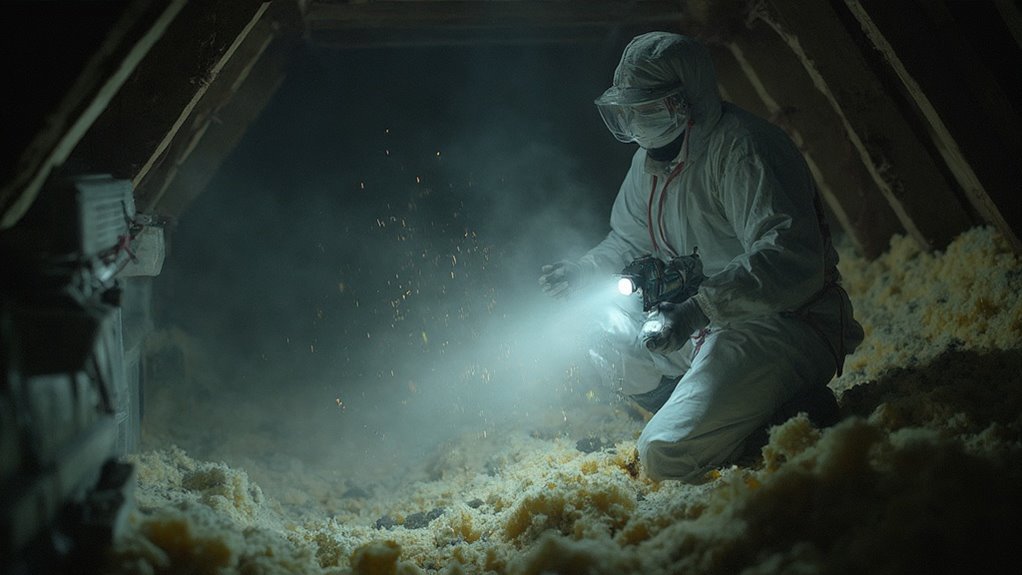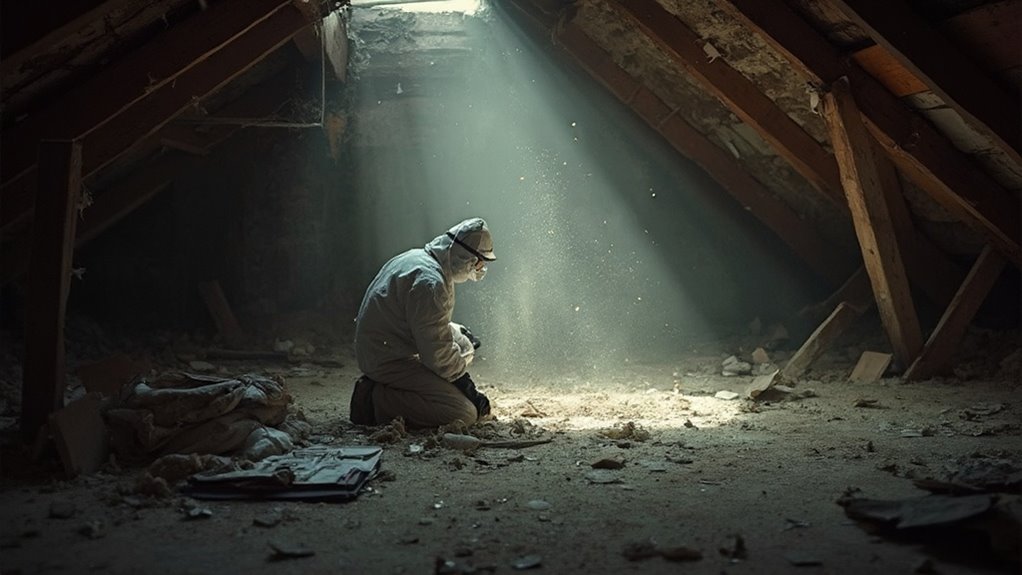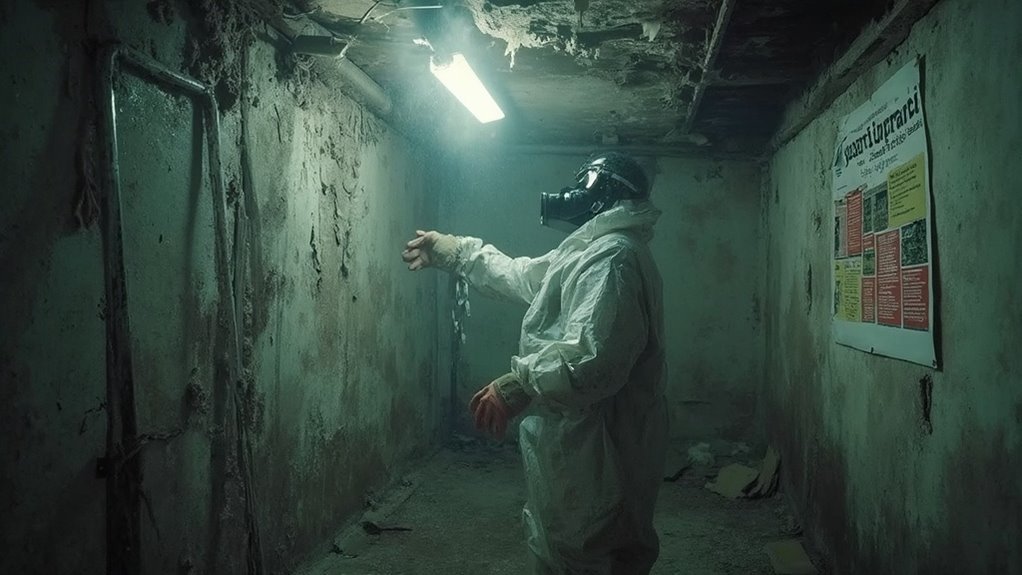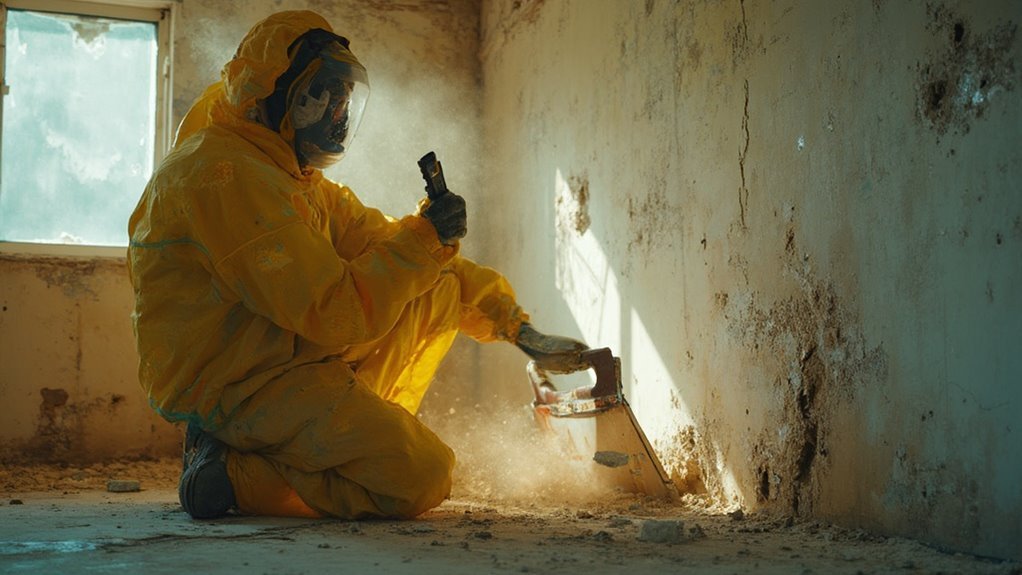Asbestos abatement is fundamental for safeguarding your health and property from the harmful effects of asbestos exposure. This process involves sealing work areas, using wet methods to minimize dust, and ensuring worker safety through personal protective equipment. Prior to any demolition or renovation, a thorough asbestos survey is significant to identify risks. Familiarity with EPA regulations is imperative for compliance, as is maintaining detailed records of all activities. It's important to act sooner rather than later, as the latency period for asbestos-related diseases can be up to 50 years. Staying informed will empower you to make important decisions regarding this critical issue.
Understanding Asbestos Abatement

Asbestos abatement is a vital process aimed at managing the risks associated with asbestos exposure, a serious health hazard linked to diseases like lung cancer and mesothelioma. Many people hold asbestos myths, underestimating its dangers or believing that encapsulation alone is sufficient. Understanding the realities of asbestos abatement is significant for guaranteeing safety.
The primary objective of asbestos abatement is to control the release of asbestos fibers, particularly in older buildings where asbestos is often found in insulation, roofing, and flooring materials. Various abatement technologies are employed to effectively manage these risks. Certified professionals begin with an inspection to confirm the presence of asbestos, followed by sealing the affected area to prevent airborne contamination. Asbestos is classified as a known carcinogen, emphasizing the critical need for effective abatement procedures. Proper disposal of asbestos waste is essential to prevent future contamination and ensure safety.
Removal techniques are vital; materials are ideally taken out intact or in large sections to minimize fiber release. High-efficiency particulate air (HEPA) filtration systems and wet cleaning methods are standard for cleanup. Compliance with OSHA and EPA regulations guarantees that proper safety measures, including personal protective equipment (PPE) and restricted access to work areas, are strictly followed. By dispelling myths and understanding the technologies involved, you can appreciate the importance of thorough asbestos abatement.
The Abatement Process Explained
Understanding the realities of asbestos abatement sets the stage for an in-depth exploration of the abatement process itself. The process involves meticulous preparation, containment, and removal techniques to guarantee safety and effectiveness.
| Step | Description | Impact |
|---|---|---|
| Sealing Work Areas | Use plastic sheeting and negative air pressure machines to prevent fiber spread. | Protects unaffected areas. |
| Removal Techniques | Wetting, hand tools, and double bagging are crucial for minimizing dust. | Reduces airborne fibers. |
| Encapsulation Methods | Sealing materials with special coatings halts fiber release. | Provides a safer environment. |
During abatement, workers don personal protective equipment (PPE) and adhere to strict safety protocols. Removal techniques involve wetting down materials to control fiber dispersion and using specialized hand tools to minimize dust creation. Encapsulation methods, such as sealing with paint or foam, are critical when full removal isn't feasible. Additionally, the post-removal verification process ensures that the property is free from any hazardous materials.
The decontamination phase follows, guaranteeing that microscopic particles are captured and hazardous materials are disposed of properly. Each step of the process is fundamental to safeguarding health and preventing exposure to asbestos fibers.
Importance of Preparation and Inspection

Before beginning asbestos abatement, a thorough asbestos survey is crucial to identify and assess risks. Accurate material sampling by certified professionals guarantees the correct approach to removal or encapsulation. Furthermore, verifying the credentials of your contractor is necessary for compliance and safety throughout the process.
Comprehensive Asbestos Survey
A thorough asbestos survey is essential for any building project, especially when dealing with structures built prior to 2000. This process involves meticulous preparation and inspection to guarantee effective asbestos management. The right survey methodologies are vital for asbestos identification and understanding the condition of asbestos-containing materials (ACMs).
| Survey Type | Objective | Key Components |
|---|---|---|
| Baseline Survey | Establish initial conditions | Review previous surveys |
| Project Design Survey | Guide renovation planning | Evaluate potential ACMs |
| Pre-Construction Survey | Confirm safety before work begins | Risk assessment and compliance |
Each survey type serves a distinct purpose, so setting clear objectives is critical. You must obtain and review relevant information about the building to guarantee compliance with regulations. A thorough examination of all areas, from ceilings to insulation, is necessary for accurate material identification. Furthermore, evaluating the condition of ACMs helps determine if removal or management is required. By conducting an extensive asbestos survey, you not only protect your project but also safeguard the health of occupants and avoid costly legal repercussions.
Accurate Material Sampling
Accurate material sampling is crucial for minimizing health risks associated with asbestos exposure, especially when dealing with potentially hazardous materials. The right sampling techniques can greatly reduce the risk of fiber release, guaranteeing a safer environment for everyone involved. Here's what you need to keep in mind for effective sampling:
- Always use a qualified person for sampling, as they have the necessary training and experience.
- Wet the area with a detergent solution to minimize asbestos fiber release during the process.
- Collect a sufficient number of bulk samples to meet industry standards.
- Use tools that minimize disturbance, like small knives or corers, to make sure the material remains intact.
- Isolate the sampling area and shut down any heating or cooling systems to prevent airborne fibers from spreading.
Licensed Contractor Verification
Guaranteeing the safety of asbestos abatement relies not only on proper material sampling but also on the verification of licensed contractors. It's essential to confirm that your contractor meets all licensing requirements. This includes state-issued licenses, passing specific exams, and adhering to regulations from the Department of Industrial Relations' Division of Occupational Safety and Health.
Here's a quick overview of what to check when verifying a licensed contractor:
| Criteria | Importance | Verification Method |
|---|---|---|
| Contractor Qualifications | Guarantees competency in abatement work | Check state certification records |
| Licensing Requirements | Legal compliance to perform abatement | Review state licensing documentation |
| Insurance | Protects against potential liabilities | Request proof of workers' compensation insurance |
| Experience | Indicates reliability and skill | Ask for references and project history |
| Training | Guarantees knowledge of safety protocols | Verify completion of accredited training courses |
Ensuring Worker Safety
To guarantee worker safety during asbestos abatement, you must prioritize personal protective equipment, effective containment measures, and rigorous air quality monitoring. Each of these elements plays an essential role in minimizing exposure to harmful asbestos fibers. By implementing these safety protocols, you can greatly reduce health risks for everyone involved.
Personal Protective Equipment
Personal protective equipment (PPE) plays a vital role in safeguarding workers during asbestos abatement activities. Properly selected and maintained PPE not only protects you from airborne asbestos fibers but also guarantees you're following safety regulations. Here's what you need to keep in mind:
- Approved Respirators: Use half-face filter respirators with P1 or P2 filters, confirming they comply with Australian Standard AS1716.
- Disposable Coveralls: Wear disposable coveralls to prevent contamination of your clothing.
- Gloves: Utilize single-use gloves to keep asbestos fibers from getting under your fingernails or into cuts.
- Footwear: Choose non-laced gumboots made from durable materials, which can be easily decontaminated.
- Post-Work Hygiene: Shower thoroughly after work, including washing your hair, to remove any asbestos fibers from your body.
Maintaining your equipment is vital. Inspect your PPE regularly for wear and tear, confirming it remains effective. After use, carefully remove and seal contaminated clothing in asbestos waste bags. By prioritizing personal hygiene and proper equipment maintenance, you'll greatly reduce the risk of asbestos exposure during abatement activities.
Containment Measures
Effective containment measures are crucial in managing asbestos abatement safely. By implementing proper containment strategies, you can greatly reduce the risk of fiber exposure to workers and the surrounding environment. These strategies involve sealing contaminated areas, minimizing disturbance, and utilizing specialized filtration systems.
Here's a quick overview of key containment measures:
| Containment Strategy | Description | Purpose |
|---|---|---|
| Sealing Contaminated Areas | Use plastic sheeting and tape to seal off areas. | Prevents fiber escape and contamination. |
| Minimizing Disturbance | Apply wet methods to ACM; avoid disruptive activities. | Reduces fiber release during abatement. |
| Specialized Filtration | Implement air filtration units to capture fibers. | Maintains a safe workspace and clean air. |
These containment measures are fundamental for effective fiber management. They guarantee that asbestos fibers remain secured, protecting both workers and the wider environment. By following these procedures, you're taking crucial steps toward safe asbestos abatement and safeguarding your health and that of others around you.
Air Quality Monitoring
After implementing containment measures, the next step in guaranteeing worker safety during asbestos abatement is air quality monitoring. This process is vital for complying with OSHA regulations and protecting both workers and building occupants from asbestos exposure. Effective monitoring techniques guarantee that any asbestos fibers released into adjacent areas are detected early, allowing for swift action.
Here are some key air quality monitoring objectives:
- Guarantee compliance with OSHA regulations for asbestos exposure.
- Determine if asbestos fibers are released from the containment area.
- Evaluate the effectiveness of abatement procedures through clearance testing.
- Assess worker exposure levels against permissible exposure limits (PELs).
- Provide data for long-term health monitoring of building occupants.
To achieve these objectives, you'll need to employ various monitoring techniques, including perimeter air monitoring and air sample analysis using Phase Contrast Microscopy (PCM) and Transmission Electron Microscopy (TEM). Regular air sampling during and after abatement activities is fundamental, as is final clearance testing to confirm the area's safety for re-entry. By prioritizing air quality monitoring, you not only adhere to regulatory requirements but also guarantee a safer environment for everyone involved.
Navigating Regulations and Compliance

When dealing with asbestos abatement, understanding the maze of regulations and compliance requirements is critical for both safety and legal adherence. The Environmental Protection Agency (EPA) enforces federal regulations through the National Emission Standards for Hazardous Air Pollutants (NESHAP), which establish guidelines for asbestos removal. You'll face compliance challenges at every level—federal, state, and local. For instance, states like New York and Michigan have specific licensing requirements for contractors.
Before any demolition or renovation, you must conduct a thorough inspection to identify asbestos-containing materials (ACM) and submit notifications to relevant authorities at least 10 days prior to starting abatement activities. Only certified personnel should handle ACM, and strict work practices are imperative to prevent fiber release. It's essential to keep detailed records of all abatement activities, as inspectors have the right to review these documents.
Stay informed about regulatory updates, as non-compliance can lead to severe penalties, including fines and even imprisonment. By maneuvering through these regulations carefully, you can guarantee a safer environment and avoid legal repercussions. Adhering to these guidelines not only protects you but significantly contributes to public safety.
Health Risks Associated With Asbestos
Asbestos poses considerable health risks that can persist long after exposure, making awareness fundamental for anyone who might come into contact with this hazardous material. The dangers of asbestos arise primarily from inhaling its fibers, which can lead to severe asbestos diseases such as:
- Asbestosis: An inflammatory lung condition causing shortness of breath.
- Mesothelioma: A rare cancer affecting the linings of the lungs and abdomen.
- Lung Cancer: The leading cause of death linked to asbestos exposure.
- Other Cancers: Increased risk of digestive tract, laryngeal, and ovarian cancers.
- Non-Cancerous Conditions: Pleural plaques and thickening can likewise develop.
It's imperative to note that no level of fiber exposure is considered safe. The latency period for these diseases can span 15 to 50 years, meaning symptoms might not surface until decades after initial exposure. Factors such as the amount and duration of exposure markedly influence your risk. If you suspect you've been exposed, staying vigilant about symptoms like persistent cough or shortness of breath is crucial. Early detection can be life-saving, so always inform healthcare providers about your exposure history.
Making Informed Decisions

Making knowledgeable choices about asbestos abatement is essential for guaranteeing safety and compliance with regulations. First, you need to understand the legal and regulatory framework surrounding asbestos. Familiarize yourself with federal regulations, such as the Asbestos National Emission Standards for Hazardous Air Pollutants (NESHAP), and the notification requirements that mandate informing state agencies before any demolition or renovation.
Cost considerations are critical in your decision-making process. Abatement projects vary considerably in price based on the extent of asbestos present, the professionals involved, and the necessary containment measures. Be certain to obtain multiple quotes from trained and registered contractors to confirm you're making a financially sound choice.
Additionally, timeline expectations should be clearly outlined before starting the project. Effective planning involves pre-abatement activities, project review, and a well-structured abatement procedure. Understand that unexpected delays can occur, so it's wise to factor in extra time for any unforeseen complications.
Frequently Asked Questions
How Can I Identify Asbestos in My Home?
To identify asbestos in your home, inspect flooring, ceiling tiles, and insulation for fibrous materials or specific patterns. If uncertain, consider asbestos testing through certified professionals to guarantee accurate identification and safety.
What Are the Costs Associated With Asbestos Abatement?
Steering through asbestos abatement costs is like charting a complex course; understanding cost factors is essential for budget planning. Expect averages around $2,215, but be prepared for significant variations based on removal complexity and location.
Can I Perform Asbestos Removal Myself?
You can't perform asbestos removal yourself without significant risks. DIY asbestos risks include exposure to toxic dust and legal issues arising from safety regulations. It's best to hire licensed professionals for safe and compliant abatement.
How Long Does the Abatement Process Typically Take?
Asbestos abatement's average timeline varies considerably, with removal duration typically ranging from one to five days for residential jobs. Larger, complex projects can stretch weeks, influenced by area access and asbestos type.
What Should I Do if I Suspect Asbestos Exposure?
If you suspect asbestos exposure, prioritize symptom awareness and seek medical advice immediately. Document your situation and investigate legal options, as timely action can be essential for addressing potential health issues and pursuing necessary compensation.
